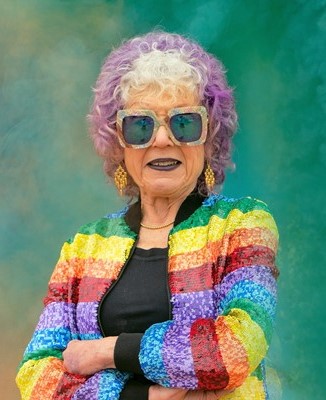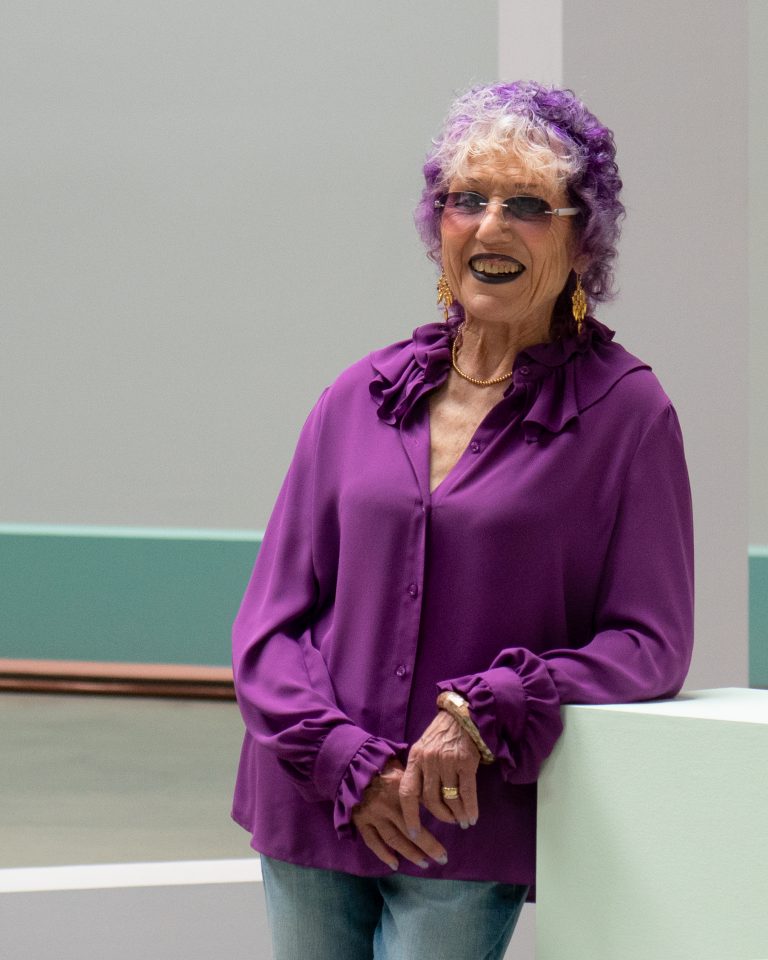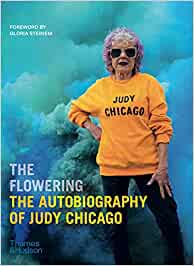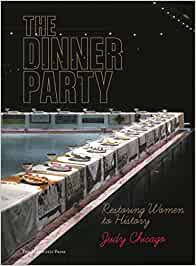
"I'm $20,000 in debt and I've had to sublet part of my studio. Every dime I've made for the last five years has gone into it. I don't know what will happen to it after its appearance in Rochester ends next year. What do I do? Take it apart? Sacrifice the rest of my career? It would cost $1,000 a month to put the piece in storage, and I'm not prepared to spend the rest of my life supporting it."
That was in 1979, after pouring all my heart, energy and money into this massive labour of love towards many of the women who have paved the way for women.
The idea for “The Dinner Party” developed directly out of my concern that as long as we women had no sense of our past, we could have no future. Our ignorance of women's history has been instrumental in maintaining our repression. The lack of respect for women by men is based on the fallacy that we've never achieved anything. Though it's caught the attention of the public, it has not received rave notices from critics, some of whom have perceived in it more message than esthetics. So I insisted that I needed to seek a wider audience than the “elitist” art world, that this item is an art that was meant to “encourage social change.
That was then and while there have been many ups, downs and “almost” in finding a home for this controversial celebration of influential women throughout history in 2002 The Dinner Party found a permanent home at the Brooklyn Museum thanks to Dr. Elizabeth Sackler.
Before this permanent home another had been proposed by the University of the District of Columbia in 1990. The university board was interested in establishing a groundbreaking multicultural museum and archive to house the art and papers of a coalition of artists of color, feminists, and others whose life and work were devoted to the struggle for freedom and dignity. It was the university’s intention to turn the Carnegie Library, which they owned, into this type of institution and there had already been an appropriation of funds by the D.C. City Council for the library’s restoration. The rest they intended to supplement with private donations.
The plan involved my donating the piece (then valued at $2 million), which in turn would form the core of the proposed museum and enlist donations of African American art in hopes of turning the school’s existing collection into a landmark assemblage. As UDC intended to charge an admission fee at the planned museum – and based on the financial history of The Dinner Party exhibitions, the university anticipated significant revenues at the gate - a contract was drawn up for me to derive a small percentage of whatever profit the university might enjoy. Never thinking that such an arrangement might appear suspect to people unfamiliar with the conditions under which I and most artists worked – that is without traditional support, with little financial reward and forced to create alternative strategies for the creation and distribution of my art – all involved were onboard.
The gifting ceremony was scheduled for July 20, my birthday, and many friends and supporters planned to fly to Washington for this momentous occasion.
A few days before the ceremony as I was walking by a kiosk displaying the Washington Times I was drawn to the front page. There in full colour were photographs of both me and The Dinner Party along with the ghastly headline: “UDC’s $1.6 million ‘Dinner.’ Feminist artwork causes some indigestion.” As I had no change with me at that moment, I couldn’t even buy the paper to find out what it was all about. When I finally read the piece, I was stunned by the outright lies about both the art and the terms of the gift.
And Here's Judy!
The article incorrectly claimed that The Dinner Party had been “banned in several art galleries around the country because it depicts women’s genitalia on plates” and that public funds were being spent to buy (and house) the work. It also erroneously implied that monies intended for UDC’s operating budget were involved. This false report was my first indication that there were any problems regarding the UDC plan. Throughout the month of June, apparently, rumors had circulated on the campus about an underground sabotage campaign being mounted by some conservative members of the faculty senate who were supposedly unhappy about the trustees’ decision to turn the Carnegie Library into a multicultural museum. There was some speculation that these were the people who had leaked the misinformation to the Times, where it seemed to dominate the news for the next few days.
I was not at all happy about this negative and distorted coverage, particularly the falsehood that the renovation money for the library was being taken from the university’s budget. Nor was the school “buying” The Dinner Party. University officials dismissed the article and advised me to put its “right-wing drivel” out of my mind. They promised to hold a press conference the day after the gifting ceremony to set the record straight. The formal transfer of ownership took place as planned and we celebrated this occasion along with my birthday.
The next day the university held a press briefing at which I presented a slide talk about The Dinner Party. Several trustees explained the vision of the museum, terms of the gift, financial arrangements and the many expected benefits to the university. This well attended event resulted in accurate articles in both the Washington Post and The New York Times. Everyone was convinced that these would stem the tide of misinformation being disseminated by the other right-wing paper. We all went home reassured, without a clue of what was to come.
Not even a week later I received a call informing me that The Dinner Party was about to be discussed by the House of Representatives. For the next hour and twenty-seven minutes, we sat stupefied in front of the televised proceedings on C-SPAN, while a war of words took place as part of a much longer debate on the UDC’s budget, which Congress controls. We watched while distortions, misrepresentations and even total fictions were read into the Congressional Record, thereby convincing even intelligent observers that some sort of hanky-panky was going on, or at the very least an irresponsible scheme. (Cont'd at Top Right)

When all was said and done the House was convinced to support a measure that deleted $1.6 million (the exact amount previously allocated for the Carnegie Hall renovations by the City; no federal funds were involved for the updates) from the university’s budget as a way of punishing the school for initiating the museum plan.
After the punitive bill passed the House, it went to the Senate, where it was taken up by the Appropriations Committee. They would be convinced to restore the money, the result of an intense lobbying campaign put into action by Susan Grode. With the help of the Hollywood Women's Political Committee—at that time, the largest fundraising group for liberal candidates in America, which Susan helped to create—she put together educational packets about The Dinner Party (emphasizing its position in many art-historical texts) that were sent to every senator.
When the right-wingers realized that they were going to be defeated in Congress they turned their attention to the university campus where the Black religious right got into the act. This led to charges of pornography and inappropriate federal funding being levelled and then blasphemy. I was called an “The Antichrist” and it was rumored that The Dinner Party had been in boxes for years because it was the Devil.
Ultimately, events in Congress, coupled with intense right-wing agitation at the university, created a breakdown of confidence in the trustees' judgment among some members of the faculty and the student body, resulting in a disruptive student strike. Unfortunately, it seemed as if The Dinner Party was becoming a lightning rod for some of the students’ previously unarticulated grievances. As the student strike intensified, so did press attention and misrepresentations. We reluctantly determined it best to withdraw the gift of The Dinner Party. I did so in a letter to the trustees at UDC and in a press release, stating that the virulent misinformation campaign had managed to create a division of values where there was none and that my life’s work had been dedicated to the right of self-determination of all people. I had no choice but to rescind the gift.
I believe that what occurred there might be more closely related to other tactics that had been used against the piece sine it was first exhibited in 1979 – specifically, the effort to prevent it from being seen. When broached with the decision to house it myself, I began to recognize that I could not single-handedly alter a world that continued to devalue women’s accomplishments.
With hindsight, I have come to believe that The Dinner Party represented a substantial challenge not only to the art world but also to the larger society, in that it directly contravenes the lack of self-worth experienced by too many women, in part through an esteeming of out bodies, as conveyed through the imagery of the plates. It is no wonder that male art critics and (those women who have internalised their loathing of all things female) and congressmen alike focused on the plates and their vulval forms. Rippling out from their tiny centers is the insistence that female sexuality is to be celebrated and embraced, hidden away, purchased, excised, or despised.
In life, as in art, from the base of self-acceptance all else issues. In the case of The Dinner Party, this meant replacing the absence of icons and celebrating female agency with a new presence, that of self-love and the honouring of the feminine. This piece was intended to help break the cycle of history that condemns each generation of women to grow up ignorant of their heritage and as the historian Gerda Lerner stated ignorant of what women before the thought and taught, a situation that persists even today.
Gratefully, things have changed so much since the 1900s. Now anyone can visit The Dinner Party at its permanent home since 2002 by visiting the Brooklyn Museum’s Feminist Art Wing thanks to Dr. Elizabeth Sackler who was celebrated by the museum for her vision in establishing the Elizabeth A. Sackler Center for Feminist Art. The Dinner Party, accounts for a large percentage of the museum’s attendance.
So, what has changed? Me? The Dinner Party? Well… we have both matured, a little. Or… is it that with more exposure and more women being able to make decisions about what women are ready and open to view as art expressing them.
I am so thrilled that my gift to women is housed in a specially built, glass-clad triangular room at the Brooklyn Museum. It is home at last.


